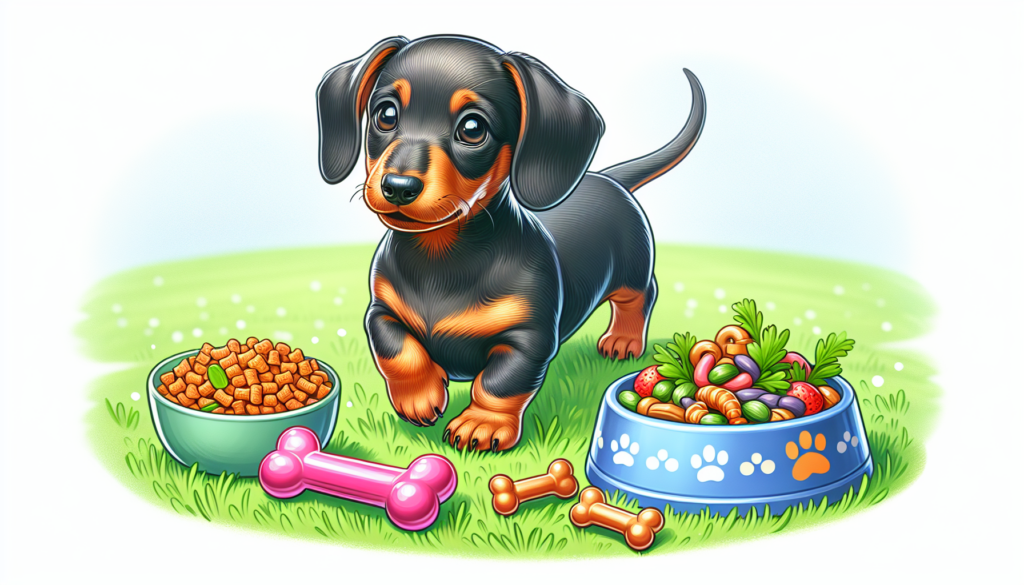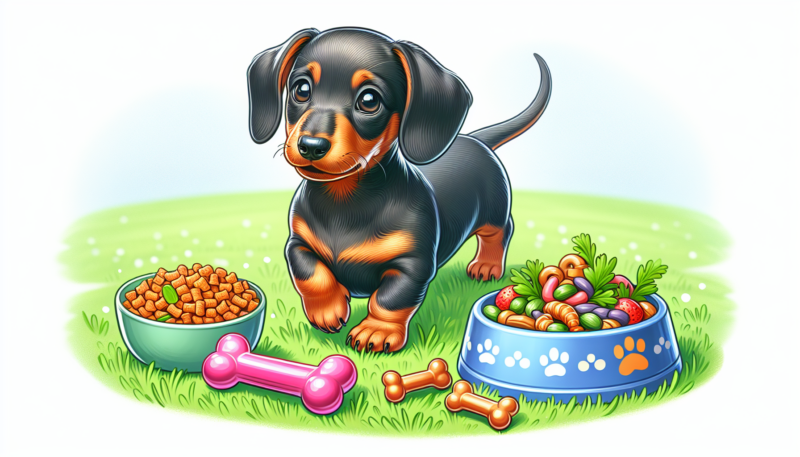If you’ve ever wondered when your beloved Dachshund will stop growing, we’ve got the answers for you. Dachshunds, also known as “wiener dogs,” are a popular breed known for their long bodies and short legs. They may not reach their full size until they are around one year old, but their rapid growth typically slows down around six months of age. Understanding when your furry friend will stop growing can help you provide the best care and ensure they thrive throughout their life. So, let’s dive into the fascinating world of Dachshund growth and find out when they reach their full potential.

Physical Development of Dachshunds
Dachshunds, known for their long bodies and short legs, go through various stages of growth and development. Understanding their physical development is essential for ensuring their overall well-being. This article will delve into the early stages of growth, height and weight development, body proportions, factors affecting growth, age milestones, growth differences in Dachshund varieties, growth charts, signs of growth completion, common growth-related concerns, and tips for caring for a growing Dachshund.
Early Stages of Growth
When a Dachshund is first born, they are small and fragile. During the first few weeks of their life, they rely entirely on their mother for nourishment and care. This stage is critical for their survival and sets the foundation for their physical development. As they grow, their bodies start to become more defined, and their muscles begin to develop. It’s important to provide a safe and comfortable environment during this delicate stage to ensure proper growth and development.
Height and Weight Development
Dachshunds, like all dogs, go through a growth process that includes an increase in height and weight. However, their growth rate may vary depending on their individual genetics, nutrition, and overall health. Generally, Dachshunds experience a rapid growth spurt during their first six months, after which their growth rate gradually slows down. By around one year of age, most Dachshunds have reached their full height.
Body Proportions
One of the distinguishing characteristics of Dachshunds is their unique body proportions. Their elongated bodies and short legs require specific attention during their growth and development. As they mature, their bodies become more proportionate, and their legs become stronger to support their unique physique. It’s crucial to monitor their body proportions and ensure they are within the standard range to prevent any strain or health issues related to their body structure.
Factors Affecting Growth
A Dachshund’s growth can be influenced by various factors. Understanding these factors will help ensure that your Dachshund develops optimally.
Genetics
Genetics plays a significant role in a Dachshund’s growth and development. The characteristics and growth potential of their parents can determine the height, weight, and body proportions of the offspring. It’s important to obtain a Dachshund from a reputable breeder who prioritizes breeding standards and health.
Nutrition
Proper nutrition is vital for a Dachshund’s growth. Providing a well-balanced diet with appropriate levels of protein, carbohydrates, fats, vitamins, and minerals is essential. The portion sizes and feeding frequency should be appropriate for their age and size. Consult with your veterinarian to ensure you are providing the best nutrition for your growing Dachshund.
Health Conditions
Certain health conditions can affect a Dachshund’s growth. Issues such as malnutrition, hormonal imbalances, and bone disorders may impede their development. Regular veterinary checkups and monitoring their overall health are crucial to detect and address any potential health concerns that may impact their growth.
Exercise
Exercise is an essential component of a Dachshund’s growth and development. It helps strengthen their muscles, promotes bone health, and provides mental stimulation. However, excessive exercise or activities that put excessive strain on their delicate backs should be avoided. Consult with your veterinarian for appropriate exercise recommendations based on your Dachshund’s age and overall health.
Age Milestones in Dachshund Growth
Dachshunds go through various stages of growth as they mature from puppies to adults. Understanding the age milestones will help you assess their development and recognize their specific needs at each stage.
Newborn Stage
The newborn stage is the first stage of a Dachshund’s life, lasting from birth until they are around two weeks old. During this stage, their eyes and ears are closed, and they rely entirely on their mother for nourishment and care. They are unable to walk or regulate their body temperature independently. It’s important to ensure a warm and safe environment during this critical stage.
Infancy Stage
The infancy stage usually lasts from two weeks to around three months. This is a crucial period for a Dachshund’s growth and development. They start to open their eyes, become more aware of their surroundings, and their body begins to fill out. They start exploring their environment and learning basic socialization skills. Adequate nutrition and regular veterinary checkups are essential during this stage.
Adolescence Stage
The adolescence stage typically occurs between three to six months of age. During this stage, Dachshunds experience a rapid growth spurt and their bodies go through significant changes. Their bones become denser, their muscles develop further, and they start to exhibit adult-like behavior. It’s important to monitor their growth and adjust their diet and exercise accordingly to support their developing bodies.
Adulthood Stage
By the age of one year, most Dachshunds have reached their full height and have completed their main growth phase. However, they may continue to fill out and develop their adult body shape until they are around 18 to 24 months old. The adulthood stage is a time when Dachshunds’ energy levels stabilize, and they become more physically and mentally mature. Maintaining a balanced diet, regular exercise, and providing mental stimulation is important to support their overall well-being.
Growth Differences in Dachshund Varieties
Dachshunds come in three varieties: standard, miniature, and toy. Each variety has its own specific growth characteristics.
Standard Dachshunds
Standard Dachshunds are the largest variety and generally have a longer growth period compared to miniature and toy Dachshunds. They typically reach their full height between 12 to 18 months of age. Their average weight ranges from 16 to 32 pounds, depending on their overall condition and genetics.
Miniature Dachshunds
Miniature Dachshunds are smaller than standard Dachshunds but larger than toy Dachshunds. They usually reach their full height by around 12 months of age. Their average weight ranges from 9 to 15 pounds, although some individuals may exceed or fall below this range.
Toy Dachshunds
Toy Dachshunds are the smallest variety and have the shortest growth period. They typically reach their full height by around 10 months of age. Their average weight ranges from 8 pounds and below, with some toy Dachshunds being as light as 5 pounds. It’s important to provide extra care and attention to their fragile bodies due to their small size.

Growth Charts for Dachshunds
Growth charts are valuable tools for monitoring a Dachshund’s growth and ensuring they are developing at a healthy rate. These charts provide reference ranges for height, weight, and body proportions at different ages.
Importance of Growth Charts
Growth charts help track a Dachshund’s growth trajectory and provide a visual representation of their progress. By comparing their measurements to the appropriate growth chart, you can identify any potential growth concerns or deviations from the standard range. Discussing any discrepancies with your veterinarian can help address any underlying issues and tailor their care accordingly.
Typical Growth Patterns
Dachshunds generally follow a predictable growth pattern. They experience a rapid growth spurt during their first six months, after which their growth rate gradually slows down. Throughout their growth, it’s important to maintain a steady increase in height and weight, while ensuring their body proportions remain within the standard range. Regular measurements and tracking their growth using a growth chart will help assess their progress.
Signs of Growth Completion in Dachshunds
Determining when a Dachshund has reached its full growth can be challenging. However, there are signs you can observe that indicate their growth has likely completed.
Bone Structure Maturation
When a Dachshund’s bone structure has fully matured, it often signifies the end of their growth phase. You may notice that their bones feel denser and more solid. Keep in mind that while their bones may have matured, their bodies may continue to fill out gradually until they reach their adult body shape.
Ceased Changes in Height and Weight
If your Dachshund’s height and weight have remained relatively constant for an extended period, it is likely that they have completed their growth. However, it’s important to take into consideration that weight fluctuations can occur due to factors such as diet, exercise, and overall health.
Common Growth-Related Concerns
As Dachshunds grow, certain concerns may arise that require attention and care. Understanding these common growth-related concerns will help you better care for your Dachshund.
Delayed Growth
If a Dachshund’s growth rate is significantly slower than the usual milestones or if they are consistently smaller than other Dachshunds of the same age and variety, it may indicate delayed growth. Delayed growth can be caused by various factors, including genetics, nutrition deficiencies, hormonal imbalances, or underlying health conditions. Consult with your veterinarian to determine the cause and appropriate steps for addressing delayed growth.
Excessive Growth
While it’s essential for a Dachshund to grow at an appropriate rate, excessive growth can also be a concern. Rapid and excessive growth can put strain on their developing bones and joints and may lead to skeletal issues. Ensuring a balanced diet, providing regular exercise, and monitoring their growth closely can help prevent excessive growth.
Weight Management
Maintaining a healthy weight is crucial for a Dachshund’s overall well-being. Being overweight can lead to various health problems, including joint issues and an increased risk of spinal injuries. On the other hand, being underweight can indicate malnutrition or underlying health issues. Regularly monitor your Dachshund’s weight, adjust their diet as needed, and consult with your veterinarian if you have concerns about their weight management.
Caring for a Growing Dachshund
Caring for a growing Dachshund involves providing them with the proper care, nutrition, and attention they need throughout their various growth stages.
Regular Vet Checkups
Regular veterinary checkups are essential to monitor your Dachshund’s growth, address any concerns promptly, and ensure they are receiving optimal care. Your veterinarian can assess their overall health, offer guidance on nutrition, provide vaccinations and preventive treatments, and monitor their growth using growth charts.
Balanced Diet and Nutrition
A well-balanced diet is crucial for a Dachshund’s growth and development. Provide high-quality, age-appropriate dog food that meets their nutritional needs. Consult with your veterinarian regarding portion sizes, feeding frequency, and any necessary dietary adjustments throughout their growth stages. Avoid overfeeding or feeding inappropriate human foods, as this can lead to weight issues and potential health complications.
Exercise and Physical Activity
Regular exercise is important for a growing Dachshund’s physical and mental well-being. However, it’s crucial to provide appropriate exercise based on their age and overall health. Engage them in activities that promote muscle development, such as short walks, interactive play sessions, and mental stimulation. Avoid high-impact activities that can strain their delicate backs, especially during their growth phases.
Proper Training
Training plays a crucial role in a Dachshund’s growth and development. Early socialization and obedience training help them become well-rounded companions and ensure their safety. Consistent and positive reinforcement-based training methods can help shape their behavior and instill good habits from an early age. Seek guidance from professional trainers or enroll them in puppy classes to ensure they receive proper training.
Final Thoughts
Understanding the physical development of Dachshunds is vital for providing them with the best care throughout their growth stages. From the early stages of growth to milestones and beyond, each phase requires attention, monitoring, and tailored care. By being vigilant about their health, nutrition, exercise, and overall well-being, you can ensure your Dachshund thrives and enjoys every stage of their growth journey.
